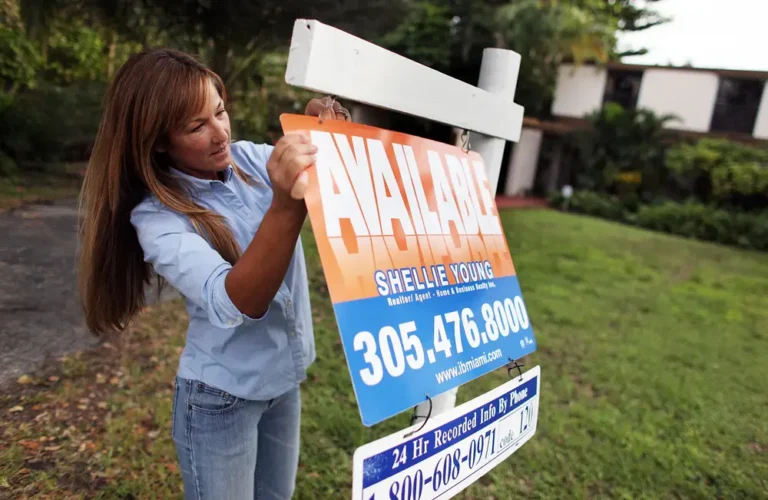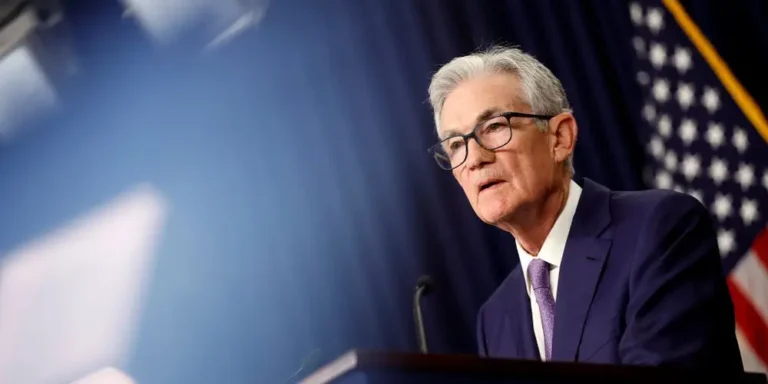Is the office the next ‘Big Short?’ A trader who returned 119% betting against shopping malls shares his playbook

- Dan McNamara’s Polpo Capital is shorting office real estate, a risky move that could be lucrative.
- The trade has drawn comparisons to “The Big Short,” which McNamara says is overblown.
- His office playbook includes some shorting, distressed-debt buys, and interest-only loans.
Dan McNamara’s office is on the 19th floor of a plain office building in midtown Manhattan. From his conference room overlooking Sixth Avenue, just south of Central Park, he can see a sea of concrete and steel skyscrapers representing the world’s largest office-property market, according to the New York City comptroller.
It’s more than a magnificent sight displaying hundreds of years of blood, sweat, and progress for McNamara. It’s also a good time to invest.
McNamara, 41, is the cofounder and chief investment officer of Polpo Capital, a small hedge fund founded in 2021 to bet on commercial-real-estate distress in the aftermath of the COVID-19 pandemic, which has changed the way Americans shop, work, and interact in large cities like New York.
In 2020, he made a name for himself by shorting a real-estate-debt instrument linked to shopping malls, resulting in a 119% return for his investors in just three months. The mall trade, which also resulted in large profits for billionaire Carl Icahn, has been dubbed the Big Short 2.0, in reference to the handful of traders who made millions shorting the housing market in the run-up to the Great Recession, which inspired a best-selling book and Hollywood film.
Now, he and a few other reputable hedge-fund managers are anticipating a $500 billion drop in office valuation as the next big payday. In a May research paper titled “The Office Real Estate Apocalypse,” researchers from New York University and Columbia discovered that office valuations fell by $506 billion between 2019 and the beginning of this year. Many short-sellers of office real estate see little reason to expect that decline to improve as the number of people who use some form of remote work grows, implying a more permanent shift in our work culture.
Look no further than McNamara’s X (formerly Twitter) feed to get a sense of his market perspective. It serves as an almanac of almost every media report on commercial-real-estate distress. If you’re looking for a doomsday commercial real estate vision, look no further.
“We believe losses will be comparable to, if not worse than, the GFC,” McNamara said, referring to the 2007-2008 global financial crisis. “There are cyclical issues in many sectors, but there is a secular issue in office that I don’t think will ever improve.”
Predictions of a sustained office apocalypse have also piqued the interest of well-known short-seller Jim Chanos of Kynikos Associates, known for its bets against the defunct energy company Enron, and the $20 billion credit hedge fund Marathon Asset Management. Experts say shorting office real estate will be far more complicated — and riskier — than shorting malls, prompting some to call it the next “widow-maker” trade.
Despite his belief that the office disruption will be significant, McNamara agreed with critics who claimed that shorting this market would not make anyone extremely wealthy — or lead to any movie deals.
“I don’t think this is the’Big Short,'” McNamara said.
This isn’t to say he doesn’t have a strategy for profiting from cultural shifts that could forever alter the state of commercial real estate. On August 1, McNamara spoke with Insider in his office about his short positions, his thoughts on commercial-real-estate bonds worth owning, and how he planned to profit when the market finally bottomed.
Who exactly is Dan McNamara?
McNamara began his career in 2004, and by the time of the Great Recession, he was a commercial-mortgage-backed securities trader at UBS. It was a frightening time for anyone in the industry, with asset values plummeting, a banking crisis, and new CMBS issuance dropping from $229 billion in 2007 to $3 billion in 2009. He attributed those dark days to his bearish views, which he said he shared with many traders in that segment.
McNamara left UBS in 2009, then worked briefly on the trading desks of Braver Stern & Co. and Societe Generale before joining MP Securitized Credit Partners, a distressed securities fund spun out of Credit Suisse in 2002, where he stayed for nearly ten years.
By the end of 2019, McNamara and his team had turned their attention to the rapidly deteriorating conditions of America’s shopping malls. The shift to e-commerce was depleting America’s brick-and-mortar retailers, forcing department stores out of business and leaving malls with high vacancies.
Seeing this, McNamara and his team created a white paper outlining a strategy for profiting from troubled malls by using a collection of financial indexes that tracked commercial-mortgage-backed securities. These indexes, known as CMBX, are divided into 25 segments, known as “tranches,” which represent various loans, each with its own rating. McNamara and his team concentrated on CMBX 6, a collection of loans from 2012 with a high exposure to troubled malls.
MP had already been shorting this tranche, but McNamara said they saw a bigger opportunity and began raising funds for a short-only fund. MP Opportunity Fund was established in February 2020 with the goal of focusing on the mall trade for a period of five to six years.
Then the coronavirus, which had been wreaking havoc in China and Italy, made its way to the United States.
McNamara, his wife, and their two young sons were dividing their time at the time between their home in Westchester, New York, and their apartment in the Manhattan neighborhood of Tribeca. His family relocated to Westchester the week New York ordered non-essential workers to stay at home indefinitely.
“We never slept in Tribeca again,” McNamara confessed.
He had witnessed firsthand the havoc that COVID-19 was wreaking on the real estate market. His fund also noticed it.
McNamara’s brief
While some may imagine a short trader as a brash, overconfident cowboy in the slickest suit available, McNamara was dressed like a dad relaxing after a day at the golf course, with a tucked-in golf polo bearing Polpo’s octopus logo, navy pants, and suede loafers. McNamara didn’t come across as a big risk-taker during the interview, but his confidence in the trade was contagious.
According to Bloomberg, McNamara and his colleagues raised approximately $100 million in 2021 to launch Polpo Capital.
“It was born with the idea that commercial real estate and CMBS credit are going to be the heart of distress, and they will provide the next opportunity, just like residential did in 2008 and 2009,” he said, referring to the real-estate meltdown that defined the early years of his trading career.
Along with McNamara, there are four other portfolio managers at the fund, including his colleague Josh Nester, who McNamara says spends “every hour of every day underwriting” who will be a winner or a loser in commercial real estate.
Polpo is primarily interested in shorting CMBX tranches 12, 13, and 14. No CMBX tranche is entirely comprised of a single asset class, but office-property loans account for up to one-third of the assets in these groups, more than any other. And, while he is most bearish on office property, he expects further distress in commercial real estate overall.
He is shorting the BB tranche of the tranches. Despite the fact that these BB indexes are already trading around $0.60 on the dollar, a July 25 Bank of America research note predicted that some of them could trade below $0.20.
In an attempt to demonstrate how bad things could get, McNamara mentioned a CMBX 6 tranche asset: the Crystal Mall in Waterford, Connecticut. It was appraised at $155 million at one point, and Simon Property Group owed $81 million on the property. It was auctioned off earlier this year for $9.25 million.
Because these indexes have high carrying costs of 500 basis points, Polpo must pay a significant amount to keep the bet going. He claims that the returns on his long positions allow him to hold these shorts until prices truly collapse and the bet pays off, even if it takes a few years. According to Bloomberg, these long positions can return 7% to 8% after deducting the costs of the short position.
There are many critics of the office-short trade. There is the risk of high carrying costs in the slow-moving (even during a crisis) world of commercial real estate, as well as the risk that much of the distress has already been priced in and valuations will not fall for much longer.
Because of these risks, Morgan Stanley CMBS trader Kamil Sadik wrote in a March 6 note that betting on office distress now, after most of the declines had been priced in, “was viewed as psychotic.”
McNamara stated that his team had accounted for everything and that they still believed in the deal.
The reason he believes the trade will not be the next “Big Short” has nothing to do with its likelihood of success. According to him, the trade will never be large enough to result in a jackpot. Shorting requires someone on the other side of the transaction to put money into it, limiting the amount of money that can be made on these transactions. And the capital is missing.
There were more than $2 billion in positions to short with CMBX 6, but there are only a few hundred million dollars worth of investments to bet against in the three tranches he’s shorting now. There aren’t a lot of people McNamara can short against.
“There’s not a lot of people sitting around their boardroom saying, ‘You know what? I want to get long right now on office,'” McNamara explained
Where he’s going in the long run
One risk of shorting real estate is that it is more vulnerable to what is known in real-estate circles as “extend and pretend.” Rather than letting a transaction die, both the lender and the borrower will agree to push off the maturity date of a loan in the hope that conditions improve and everyone can resume business as usual without default.
The borrower’s main disadvantage is higher interest costs. Because of the high carry costs, it can mean a slow death for the short seller.
“Time is your enemy,” said Manus Clancy, a senior managing director at Trepp, a data firm that specializes in structured finance in commercial real estate. “It also requires a really stiff upper lip, patience, conviction, and the willingness to accept that it may not work out, and not everyone has that risk tolerance.”
That’s why McNamara’s short positions — which would outperform if office values fell sooner — are being matched with investments in a type of bond that will outperform in the face of “extend and pretend.”
Interest-only commercial mortgage-backed securities are linked to loan interest rather than principal. Betting on interest-only CMBS is a bet that the property owner will look to extend the loan rather than pay it off in full, which means they will likely have to pay more interest than was originally budgeted for the loan.
If the loans are not extended for whatever reason, whether by default or because they have been paid off, the investor may not receive the expected return.
“You just have to avoid the ones where the keys will be returned next week,” McNamara said.
McNamara’s third strategy involves buying bonds on the cheap when the market finally bottoms out, then profiting as things begin to turn positive. This strategy is based on a series of trades that occurred following the Great Recession, when traders saw opportunities in mortgage-backed securities that had bottomed out.
Trepp’s Clancy said of the post-financial-crisis era that hedge-fund tycoon David Tepper’s Appaloosa was among the first to recognize that some bonds were selling at such deep discounts that it could buy them for $0.20 to $0.50 on the dollar. The firm rode the bonds back up to par, making a fortune alongside their legendary trade betting on banks’ ability to recover from the crisis.
After the Great Recession, McNamara also purchased deeply discounted bonds at MatlinPatterson.
He believes the CMBX market has a long way to go before bottoming out, and it all depends on how many loans fall into the “extend and pretend” category. Clancy, on the other hand, stated that distressed sales in some markets, such as Baltimore and San Francisco, suggested that the bottom may be closer than some people believe. He believes the bottom will be reached within the next six months to two years, whereas McNamara believes it will take at least a year or two, if not longer.
Once the bottom is reached, McNamara plans to focus on two types of bonds, beginning with “fallen angels,” or investment-grade buildings that have been downgraded and sold off in a fire sale. The strategy is to purchase and then wait for the market to recover.
The other strategy is to purchase control bonds, a technique known as “capture the flag,” in which an investor purchases the portion of the CMBS pool with the most control over the property, giving Polpo the ability to influence either the management of the building or how the bonds are liquidated to maximize return.
“We want to be able to play offense when everyone else will be playing defense,” McNamara explained.
The Office’s Future
McNamara anticipates that the view from his 35-story office tower will remain largely unchanged in a few years. He doesn’t expect to see a bunch of empty lots or office towers warped into futuristic-looking apartments. He’s not expecting tumbleweeds or a post-apocalyptic scene from HBO’s “The Last of Us.”
He promotes hybrid work at his own company. He claims that in an office full of young parents, hybrid flexibility has become a necessity. In his line of work, it’s also necessary to meet in person to brainstorm and see clients. He may be betting against offices, but he intends to continue working in one at least part-time.
Even a brief government intervention or a swift dovish turn by the Federal Reserve will not be enough to save office landlords, according to McNamara. McNamara believes the office collapse is unavoidable unless the federal government orders people to return to work.
“Eventually, for lower-quality offices with vacancies around 40% or 50%, the debt will need to be wiped out, and a new owner will have to come in who is happy with cash flow at that level,” McNamara said.
Some of these new owners may consider converting them into apartments. Yes, some of the less desirable office properties will have to be demolished and replaced with vacant lots.
“Some buildings will have to be demolished,” McNamara said. “No one is paying off that mortgage.”






